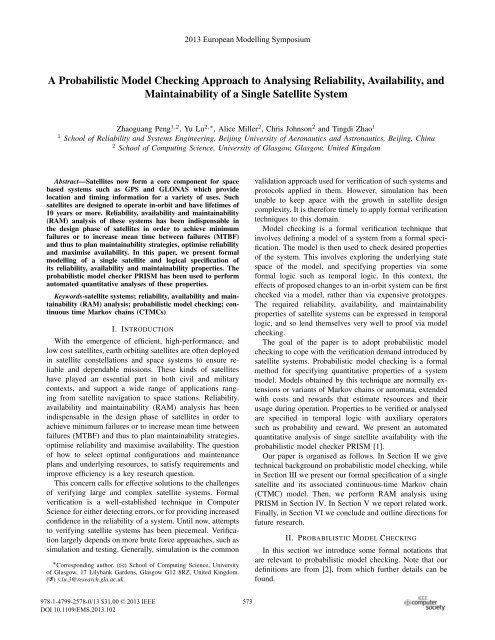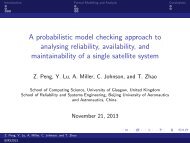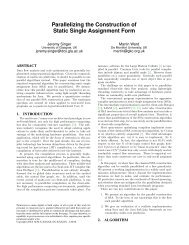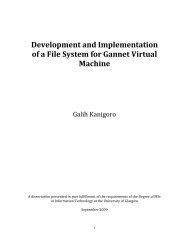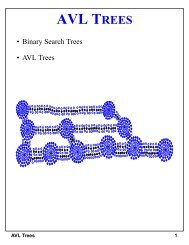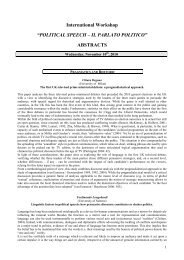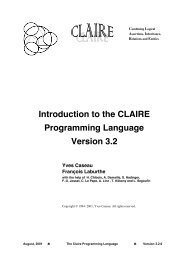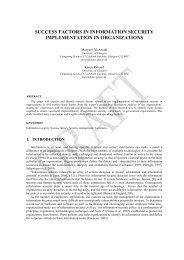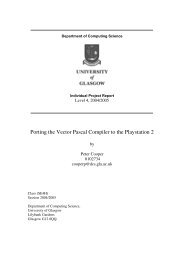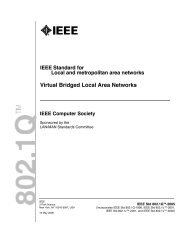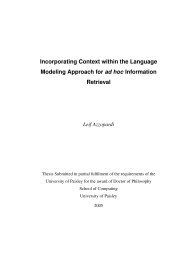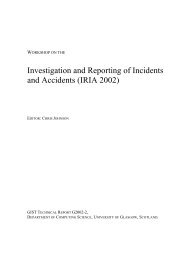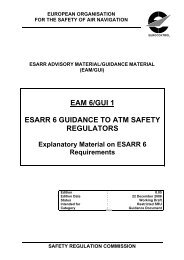A Probabilistic Model Checking Approach to Analysing Reliability ...
A Probabilistic Model Checking Approach to Analysing Reliability ...
A Probabilistic Model Checking Approach to Analysing Reliability ...
Create successful ePaper yourself
Turn your PDF publications into a flip-book with our unique Google optimized e-Paper software.
2013 European <strong>Model</strong>ling Symposium<br />
A <strong>Probabilistic</strong> <strong>Model</strong> <strong>Checking</strong> <strong>Approach</strong> <strong>to</strong> <strong>Analysing</strong> <strong>Reliability</strong>, Availability, and<br />
Maintainability of a Single Satellite System<br />
Zhaoguang Peng 1,2 ,YuLu 2,∗ , Alice Miller 2 , Chris Johnson 2 and Tingdi Zhao 1<br />
1 School of <strong>Reliability</strong> and Systems Engineering, Beijing University of Aeronautics and Astronautics, Beijing, China<br />
2 School of Computing Science, University of Glasgow, Glasgow, United Kingdom<br />
Abstract—Satellites now form a core component for space<br />
based systems such as GPS and GLONAS which provide<br />
location and timing information for a variety of uses. Such<br />
satellites are designed <strong>to</strong> operate in-orbit and have lifetimes of<br />
10 years or more. <strong>Reliability</strong>, availability and maintainability<br />
(RAM) analysis of these systems has been indispensable in<br />
the design phase of satellites in order <strong>to</strong> achieve minimum<br />
failures or <strong>to</strong> increase mean time between failures (MTBF)<br />
and thus <strong>to</strong> plan maintainability strategies, optimise reliability<br />
and maximise availability. In this paper, we present formal<br />
modelling of a single satellite and logical specification of<br />
its reliability, availability and maintainability properties. The<br />
probabilistic model checker PRISM has been used <strong>to</strong> perform<br />
au<strong>to</strong>mated quantitative analyses of these properties.<br />
Keywords-satellite systems; reliability, availability and maintainability<br />
(RAM) analysis; probabilistic model checking; continuous<br />
time Markov chains (CTMCs)<br />
I. INTRODUCTION<br />
With the emergence of efficient, high-performance, and<br />
low cost satellites, earth orbiting satellites are often deployed<br />
in satellite constellations and space systems <strong>to</strong> ensure reliable<br />
and dependable missions. These kinds of satellites<br />
have played an essential part in both civil and military<br />
contexts, and support a wide range of applications ranging<br />
from satellite navigation <strong>to</strong> space stations. <strong>Reliability</strong>,<br />
availability and maintainability (RAM) analysis has been<br />
indispensable in the design phase of satellites in order <strong>to</strong><br />
achieve minimum failures or <strong>to</strong> increase mean time between<br />
failures (MTBF) and thus <strong>to</strong> plan maintainability strategies,<br />
optimise reliability and maximise availability. The question<br />
of how <strong>to</strong> select optimal configurations and maintenance<br />
plans and underlying resources, <strong>to</strong> satisfy requirements and<br />
improve efficiency is a key research question.<br />
This concern calls for effective solutions <strong>to</strong> the challenges<br />
of verifying large and complex satellite systems. Formal<br />
verification is a well-established technique in Computer<br />
Science for either detecting errors, or for providing increased<br />
confidence in the reliability of a system. Until now, attempts<br />
<strong>to</strong> verifying satellite systems has been piecemeal. Verification<br />
largely depends on more brute force approaches, such as<br />
simulation and testing. Generally, simulation is the common<br />
∗ Corresponding author. () School of Computing Science, University<br />
of Glasgow, 17 Lilybank Gardens, Glasgow G12 8RZ, United Kingdom.<br />
() y.lu.3@research.gla.ac.uk.<br />
validation approach used for verification of such systems and<br />
pro<strong>to</strong>cols applied in them. However, simulation has been<br />
unable <strong>to</strong> keep apace with the growth in satellite design<br />
complexity. It is therefore timely <strong>to</strong> apply formal verification<br />
techniques <strong>to</strong> this domain.<br />
<strong>Model</strong> checking is a formal verification technique that<br />
involves defining a model of a system from a formal specification.<br />
The model is then used <strong>to</strong> check desired properties<br />
of the system. This involves exploring the underlying state<br />
space of the model, and specifying properties via some<br />
formal logic such as temporal logic. In this context, the<br />
effects of proposed changes <strong>to</strong> an in-orbit system can be first<br />
checked via a model, rather than via expensive pro<strong>to</strong>types.<br />
The required reliability, availability, and maintainability<br />
properties of satellite systems can be expressed in temporal<br />
logic, and so lend themselves very well <strong>to</strong> proof via model<br />
checking.<br />
The goal of the paper is <strong>to</strong> adopt probabilistic model<br />
checking <strong>to</strong> cope with the verification demand introduced by<br />
satellite systems. <strong>Probabilistic</strong> model checking is a formal<br />
method for specifying quantitative properties of a system<br />
model. <strong>Model</strong>s obtained by this technique are normally extensions<br />
or variants of Markov chains or au<strong>to</strong>mata, extended<br />
with costs and rewards that estimate resources and their<br />
usage during operation. Properties <strong>to</strong> be verified or analysed<br />
are specified in temporal logic with auxiliary opera<strong>to</strong>rs<br />
such as probability and reward. We present an au<strong>to</strong>mated<br />
quantitative analysis of singe satellite availability with the<br />
probabilistic model checker PRISM [1].<br />
Our paper is organised as follows. In Section II we give<br />
technical background on probabilistic model checking, while<br />
in Section III we present our formal specification of a single<br />
satellite and its associated continuous-time Markov chain<br />
(CTMC) model. Then, we perform RAM analysis using<br />
PRISM in Section IV. In Section V we report related work.<br />
Finally, in Section VI we conclude and outline directions for<br />
future research.<br />
II. PROBABILISTIC MODEL CHECKING<br />
In this section we introduce some formal notations that<br />
are relevant <strong>to</strong> probabilistic model checking. Note that our<br />
definitions are from [2], from which further details can be<br />
found.<br />
978-1-4799-2578-0/13 $31.00 © 2013 IEEE<br />
DOI 10.1109/EMS.2013.102<br />
573
Succeed<br />
Fail<br />
Finish<br />
Scheduled<br />
interruption<br />
Succeed<br />
Check<br />
spare<br />
satellite on<br />
ground<br />
Available<br />
Launch the<br />
satellite<br />
Interrupt<br />
Normal<br />
Fail<br />
Interrupt<br />
Disappear<br />
Failure<br />
Send<br />
software<br />
commands<br />
Fail<br />
Unavailable<br />
Fail<br />
Unavailable<br />
Build a<br />
new one<br />
Unscheduled<br />
interruption<br />
Check<br />
redundant<br />
satellite on<br />
obit<br />
Available<br />
Move and<br />
replace the<br />
failed one<br />
Repair on orbit<br />
Succeed<br />
Figure 1.<br />
A failure model and maintainability plan of a single satellite<br />
A. Continuous-time Markov Chains<br />
Let AP be a fixed, finite set of a<strong>to</strong>mic propositions.<br />
Formally, a continuous-time Markov chain (CTMC) C is a<br />
tuple (S,s init ,R,L) where:<br />
• S = {s 1 ,s 2 , ..., s n } is a finite set of states.<br />
• s init ∈ S is the initial state.<br />
• R : S × S → R ≥0 is the transition rate matrix.<br />
• L : S → 2 AP is a labelling function which assigns <strong>to</strong><br />
each state s i ∈ S the set L(s i ) of a<strong>to</strong>mic propositions<br />
a ∈ AP that are valid in s i .<br />
Intuitively, R(s i ,s j ) > 0 if and only if there is a transition<br />
from state s i <strong>to</strong> state s j . Furthermore, R(s i ,s j ) specifies<br />
that the probability of moving from s i <strong>to</strong> s j within t time<br />
units is 1−e −R(si,sj)·t , an exponential distribution with rate<br />
R(s i ,s j ).IfR(s i ,s j ) > 0 for more than one state s j ,a<br />
competition between the transitions originating in s i exists,<br />
known as the race condition.<br />
B. Continuous S<strong>to</strong>chastic Logic<br />
Let C = (S, s init ,R,L) be a continuous time Markov<br />
chain. In this section, we introduce Continuous S<strong>to</strong>chastic<br />
Logic (CSL) [3], [4]. CSL is inspired by the logic Computation<br />
Tree Logic (CTL) [5], and its extensions <strong>to</strong> discrete<br />
time s<strong>to</strong>chastic systems (PCTL) [6], and continuous time<br />
non-s<strong>to</strong>chastic systems (TCTL) [7]. There are two types of<br />
formulae in CSL: state formulae, which are true or false in<br />
a specific state, and path formulae, which are true or false<br />
along a specific path.<br />
Let a ∈ AP be an a<strong>to</strong>mic proposition, p ∈ [0, 1] be a<br />
real number, ⊲⊳ ∈{≤,,≥} be a comparison opera<strong>to</strong>r,<br />
and I ⊆ R ≥0 be a non-empty interval. The syntax of CSL<br />
formulas over the set of a<strong>to</strong>mic propositions AP is defined<br />
inductively as follows:<br />
• true is a state-formula.<br />
• Each a ∈ AP is a state formula.<br />
• If Φ and Ψ are state formulas, then so are ¬Φ and<br />
Φ ∧ Ψ.<br />
• If Φ is state formula, then so is S ⊲⊳p (Φ).<br />
• If ϕ is a path formula, then P ⊲⊳p (ϕ).<br />
• If Φ and Ψ are state formulas, then X I Φ and U I Ψ are<br />
path formulas.<br />
S ⊲⊳p (Φ) asserts that the steady-state probability for a Φ<br />
state meets the boundary condition ⊲⊳ p. P ⊲⊳p (ϕ) asserts that<br />
the probability measure of the paths satisfying ϕ meets the<br />
bound given by ⊲⊳ p. The path formula X I Φ asserts that a<br />
transition is made <strong>to</strong> a Φ state at some time point t ∈ I.<br />
Opera<strong>to</strong>r U I is the timed variant of the until opera<strong>to</strong>r of<br />
CTL; the path formula ΦU I Ψ asserts that Ψ is satisfied at<br />
some time instant in the interval I and that at all preceding<br />
time instants Φ holds.<br />
III. FORMAL MODELLING WITH A CTMC<br />
PRISM [1] is a probabilistic model checker. It supports<br />
the analysis of several types of probabilistic models:<br />
discrete-time Markov chains (DTMCs), continuoustime<br />
Markov chains (CTMCs), Markov decision processes<br />
(MDPs), probabilistic au<strong>to</strong>mata (PAs), and also probabilistic<br />
timed au<strong>to</strong>mata (PTAs), with optional extensions of costs<br />
and rewards. PRISM allows us <strong>to</strong> verify properties specified<br />
in the temporal logics PCTL for DTMCs and MDPs and<br />
CSL for CTMCs. <strong>Model</strong>s are described using the PRISM<br />
language, a simple, state-based language. The abstract model<br />
574
of a single satellite is illustrated in Figure 1, parameters are<br />
omitted. We take a CTMC as our underlying PRISM model<br />
for our abstract model. The detailed PRISM model of the<br />
satellite system, the property specification and the analysis<br />
results are available in [8].<br />
We specify our actual CTMC model with states, a transition<br />
rate matrix, and a labelling function. Initially, the<br />
satellite runs in the normal state. After a period of execution<br />
it could be interrupted by an scheduled or unscheduled<br />
interruption during its lifecycle. Scheduled interruptions are<br />
normally caused by certain types of Operations and Maintenance<br />
(O&M) for routine satellite. This can cause satellite<br />
signal unavailability due <strong>to</strong> the station keeps manoeuvres,<br />
a<strong>to</strong>mic clock maintenance, software updates, and hardware<br />
maintenance. Unscheduled interruptions can be caused by<br />
solar radiation, the earth’s magnetic field cosmic rays, which<br />
result in a satellite Single Event Upset (SEU). However, both<br />
scheduled and unscheduled interruptions are usually temporary,<br />
lasting just several hours. An unscheduled interruption<br />
usually disappears au<strong>to</strong>matically. The satellite can fail any<br />
time during its lifetime due <strong>to</strong> End-of-Life (EOL) outage or<br />
other vital failures.<br />
When the satellite fails, staff on the ground must decide<br />
upon the best approach <strong>to</strong> repair it. It may be possible that<br />
failures can be resolved on orbit by giving specific software<br />
commands <strong>to</strong> the satellite. Otherwise it might be necessary<br />
<strong>to</strong> move a redundant satellite in<strong>to</strong> position <strong>to</strong> replace the<br />
failed satellite. If no redundant satellite is available then a<br />
new satellite must be manufactured and launched. In the<br />
worst case, the new satellite does not launch successfully,<br />
due <strong>to</strong> a known probability of satellite launch failure.<br />
In our paper, parameter values correspond <strong>to</strong> those latest<br />
U.S. GPS system, GPS Block III satellites. The GPS III<br />
series is the newest block of GPS satellites (SVN-74 and<br />
up). GPS III provides more powerful signals than previous<br />
versions in addition <strong>to</strong> enhanced signal reliability, accuracy,<br />
and integrity. The key improvement is the 15-year design<br />
lifespan [9]. Since not all of the actual data for the GPS III is<br />
available, in this paper we instead use some parameter values<br />
associated with similar satellite systems. All parameters used<br />
in our CTMC model and properties are specified in Table I.<br />
Table I<br />
PARAMETERS FOR THE CTMC MODEL AND ANALYSES<br />
R MTBF MTTR tα p β tγ t δ tɛ pη tκ<br />
0.80 15y 24h 4320h 80% 24h 1440h 4320h 90% 24h<br />
We use p <strong>to</strong> express probability and t for time, and the<br />
reliability of the satellite is R. If the satellite fails, we say<br />
that it moves from a “normal” state <strong>to</strong> a “failure” state. Both<br />
the mean time <strong>to</strong> unscheduled interruption and the mean<br />
time <strong>to</strong> the scheduled interruption are t α . When the satellite<br />
fails, the probability of the failure being resolved in-orbit by<br />
moving a redundant satellite <strong>to</strong> replace the failed one is p β .<br />
If on orbit repair is not possible, a new satellite is needed.<br />
The times taken <strong>to</strong> decide <strong>to</strong> build a new satellite and for<br />
one <strong>to</strong> be manufactured are t γ and t δ respectively. If a new<br />
satellite is <strong>to</strong> be manufactured, the probability of successful<br />
launch is p η . After successful launch, the time taken for the<br />
satellite <strong>to</strong> move <strong>to</strong> the right position and a normal signal<br />
sent from it <strong>to</strong> be received on ground is t κ .<br />
IV. QUANTITATIVE ANALYSIS IN THE PRISM<br />
We have identified the need <strong>to</strong> analyse reliability, availability,<br />
and maintainability properties of satellite based applications.<br />
We illustrate the use of probabilistic model checking<br />
in this domain by describing our PRISM model. The<br />
reliability for a satellite consists of scheduled interruptions,<br />
unscheduled interruptions, and failure states in the system.<br />
The probability of successful launch is the reliability for<br />
the satellite. “Repaired in-orbit”is the maintainability for<br />
the satellite. <strong>Reliability</strong> and maintainability are availability<br />
properties of a satellite. <strong>Reliability</strong> must be sufficient <strong>to</strong> support<br />
the mission capability needed in its expected operating<br />
environment.<br />
If reliability and maintainability are not adequately designed<br />
in<strong>to</strong> satellite and space based systems, there is risk<br />
that design will breach desired availability or performance<br />
requirements. System performance baseline thresholds with<br />
significantly higher design or development costs due <strong>to</strong><br />
resulting corrective action costs; will cost more than anticipated<br />
<strong>to</strong> use and operate; or will fail <strong>to</strong> provide availability<br />
expected by the researchers or users.<br />
Satellite will deteriorate with time due <strong>to</strong> failure mechanisms.<br />
We assume that time delay is a random variable<br />
selected from an exponential distribution, which is an assumption<br />
used in PRISM. According <strong>to</strong> the system reliability<br />
theory [10], the reliability of a satellite from R(t) can be<br />
defined as<br />
and, then we can obtain<br />
R(t) =Pr{T >t} = e −λt , (1)<br />
λ(t) = −lnR(t)<br />
E(s i ) . (2)<br />
Satellite failures typically occur at some constant failure<br />
rate λ, failure probability depends on the rate λ and the<br />
exposure time t. Typically failure rates are carefully derived<br />
from substantiated his<strong>to</strong>rical data such as mean time between<br />
failure (MTBF). We have<br />
λ = −lnR<br />
T<br />
=⇒ λ = −lnR<br />
MTBF , (3)<br />
where t = T = MTBF, where MTBF is the design<br />
parameter or the statistics parameter. Referring <strong>to</strong> the latest<br />
characteristics of satellites used for Global Positioning<br />
575
(a) <strong>Reliability</strong> property 2 (b) <strong>Reliability</strong> property 4<br />
Figure 2.<br />
Analysis results of reliability properties.<br />
Systems (GPSs), we assume the MTBF of the satellite <strong>to</strong><br />
be 15 years. As a result, R =0.80 and MTBF =15years.<br />
Further, the mean time <strong>to</strong> repair (MTTR)is24 hours.<br />
PRISM provides support for au<strong>to</strong>mated analysis of a wide<br />
range of quantitative properties of these models, such as<br />
“what is the probability of a failure causing the satellite <strong>to</strong><br />
s<strong>to</strong>p working within 12 hours?”, “what is the worst-case<br />
probability of the satellite on-board system terminating due<br />
<strong>to</strong> an error, over all possible initial configurations?”, or “what<br />
is the worst-case expected time taken for the satellite signal<br />
<strong>to</strong> be received?”.<br />
A. <strong>Reliability</strong> Properties and Analysis<br />
<strong>Reliability</strong> properties that we can analyse using PRISM<br />
include:<br />
1) the probability that a satellite will need <strong>to</strong> be replaced by a<br />
new one in 15 years at the reliability 0.80:<br />
P =? [F
(a) Maintainability property 2<br />
Figure 3.<br />
Analysis results of maintainability properties.<br />
(b) Maintainability property 3<br />
3). It shows that if the required availability is 0.995, the<br />
time taken for scheduled interruption for the satellite will<br />
be smaller than 16 hours.<br />
V. RELATED WORK<br />
There have been a number of notable attempts <strong>to</strong> use<br />
formal methods <strong>to</strong> address the problems of design exploration<br />
for a satellite system. The theorem prover PVS [11]<br />
was used <strong>to</strong> verify desired properties in system models of<br />
Ariane 5 where cost of failure is highest. The PICGAL<br />
project [12] has analysed ground-based software for launch<br />
vehicles similar <strong>to</strong> Ariane 5. In the NASA report [13],<br />
formal methods and their approaches <strong>to</strong> critical systems are<br />
explained <strong>to</strong> stakeholders from the aerospace domain. In<br />
[14], the potential role of formal methods in the analysis of<br />
software failures in space missions is discussed. Similarly,<br />
[15] explores how verification techniques, such as static<br />
analysis, model checking, and compositional verification,<br />
can be used <strong>to</strong> gain trust in model-based systems.<br />
<strong>Model</strong> checking has been successfully applied <strong>to</strong> numerous<br />
computer systems and their applications, including both<br />
software and hardware systems [16], [17], [18], [19]. His<strong>to</strong>rically,<br />
model checking has been considered <strong>to</strong> be a powerful<br />
extension of the traditional verification process such as<br />
emulation and simulation. It has also proved <strong>to</strong> be a suitable<br />
formal technique for exposing errors in satellites, mainly<br />
due <strong>to</strong> classical concurrency errors. Unforeseen interleavings<br />
between processes many cause undesired events <strong>to</strong> happen.<br />
In [20], the SPIN model checker [21] was used <strong>to</strong> formally<br />
analyse a multithreaded plan execution module. This module<br />
is a component of NASA’s artificial intelligence-based<br />
spacecraft control system which launched in 1998 as part<br />
of the Deep Space 1 mission. Five previously undiscovered<br />
errors were identified in the spacecraft controller, in one case<br />
representing a major design flaw.<br />
The model checking <strong>to</strong>ol Murψ [22] has been used in<br />
[23] <strong>to</strong> model the Entry, Descent and Landing phase of<br />
the Mars Polar Lander. The model checker was used <strong>to</strong><br />
search for sequences of states that led <strong>to</strong> the violation of<br />
a Murψ invariant. This stated that the thrust of the pulsewidth<br />
modulation, which controls the thrust of the descent<br />
engines, should always be above a certain altitude. In [24]<br />
the model checker NuSMV [25] is used <strong>to</strong> model and<br />
verify the implementation of a mission and safety critical<br />
embedded satellite software control system. The control<br />
system is responsible for maintaining the attitude of the<br />
satellite and for performing fault detection, isolation, and<br />
recovery decisions, at a detailed level.<br />
VI. CONCLUSION AND FUTURE WORK<br />
In this paper, a range of model checkers has been employed<br />
<strong>to</strong> represent and reason about design and failure<br />
of space based systems. The traditional approaches are not<br />
suitable for analysing system reliability and performance. In<br />
this paper, we consider an au<strong>to</strong>mated verification approach -<br />
probabilistic model checking, which extends classical model<br />
checking with quantitative analysis support.<br />
Since parameter settings of our formal models are based<br />
on GPS Block III which is newest generation of GPS<br />
systems, our analysis results can be compared <strong>to</strong> existing<br />
GPS statistical analysis. In [9], the availability of the GPS<br />
Block III is given as 99.9%. The availability we evaluate<br />
in this paper is close <strong>to</strong> the actual data. This indicates<br />
that our approach is feasible and efficient. To the best of<br />
our knowledge, we are the first <strong>to</strong> use probabilistic model<br />
checking <strong>to</strong> perform RAM analysis of satellite systems.<br />
Actually, numerous failures are distributed differently<br />
other than exponential distributions. In particular, a number<br />
of failures of satellites have a Weibull distribution [10],<br />
which follows the conventional three-component bathtub<br />
curve which models a burn-in and wear-out phase for failure<br />
prediction. For future work, we will look at how <strong>to</strong> represent<br />
arbitrary distributions in probabilistic models, and <strong>to</strong> what<br />
extent such kind of distributions are able <strong>to</strong> be supported by<br />
probabilistic model checking approaches. Further, we plan<br />
<strong>to</strong> extend our work of analysing a single satellite <strong>to</strong> satellite<br />
577
(a) Availability property 2<br />
Figure 4.<br />
Analysis results of availability properties.<br />
<br />
<br />
<br />
(b) Availability property 3<br />
constellation consisting of multiple satellites.<br />
REFERENCES<br />
[1] M. Kwiatkowska, G. Norman, and D. Parker, “PRISM: <strong>Probabilistic</strong><br />
symbolic model checker,” in Computer Performance<br />
Evaluation: <strong>Model</strong>ling Techniques and Tools, ser. LNCS,<br />
T. Field, P. G. Harrison, J. Bradley, and U. Harder, Eds.<br />
Springer, 2002, vol. 2324, pp. 200–204.<br />
[2] C. Baier and J.-P. Ka<strong>to</strong>en, Principles of <strong>Model</strong> <strong>Checking</strong>.<br />
MIT Press, 2008.<br />
[3] A. Aziz, K. Sanwal, V. Singhal, and R. Bray<strong>to</strong>n, “Verifying<br />
continuous time markov chains,” in Computer Aided Verification,<br />
ser. LNCS, R. Alur and T. Henzinger, Eds. Springer,<br />
1996, vol. 1102, pp. 269–276.<br />
[4] C. Baier, J.-P. Ka<strong>to</strong>en, and H. Hermanns, “Approximative<br />
symbolic model checking of continuous-time markov chains,”<br />
in CONCUR’99 Concurrency Theory, ser. LNCS, J. C. Baeten<br />
and S. Mauw, Eds. Springer, 1999, vol. 1664, pp. 146–161.<br />
[5] E. A. Emerson, “Temporal and modal logic,” in Handbook of<br />
Theoretical Computer Science, J. van Leeuwen, Ed. Elsevier,<br />
1990, pp. 996–1072.<br />
[6] H. Hansson and B. Jonsson, “A logic for reasoning about time<br />
and reliability,” Formal Aspects of Computing, vol. 6, no. 5,<br />
pp. 512–535, 1994.<br />
[7] R. Alur, C. Courcoubetis, and D. Dill, “<strong>Model</strong>-checking for<br />
real-time systems,” in Proceedings of the 1990 Fifth Annual<br />
IEEE Symposium on Logic in Computer Science, 1990, pp.<br />
414–425.<br />
[8] http : //dcs.gla.ac.uk/ yu/index files/satellite.zip.<br />
[9] http : //www.gps.gov/systems/gps/space/III.<br />
[10] A. Høyland and M. Rausand, System <strong>Reliability</strong> Theory:<br />
<strong>Model</strong>s and Statistical Methods. Springer, 2009.<br />
[11] S. Owre, J. M. Rushby, and N. Shankar, “PVS: A pro<strong>to</strong>type<br />
verification system,” in Au<strong>to</strong>mated Deduction—CADE-11, ser.<br />
LNCS, D. Kapur, Ed. Springer, 1992, vol. 607, pp. 748–752.<br />
[12] L. Devauchelle, P. G. Larsen, and H. Voss, “PICGAL:<br />
Practical use of formal specification <strong>to</strong> develop a complex<br />
critical system.pdf,” in FME ’97: Industrial Applications and<br />
Strengthened Foundations of Formal Methods, ser. LNCS,<br />
J. Fitzgerald, C. B. Jones, and P. Lucas, Eds. Springer,<br />
1997, vol. 1313, pp. 221–236.<br />
[13] J. Rushby, “Formal methods and their role in the certification<br />
of critical systems,” in Safety and <strong>Reliability</strong> of Software<br />
Based Systems, R. Shaw, Ed. Springer, 1997, pp. 1–42.<br />
[14] C. W. Johnson, “The natural his<strong>to</strong>ry of bugs: Using formal<br />
methods <strong>to</strong> analyse software related failures in space missions,”<br />
in FM 2005: Formal Methods, ser. LNCS, J. Fitzgerald,<br />
I. J.Hayes, and A. Tarlecki, Eds. Springer, 2005, vol.<br />
3582, pp. 9–25.<br />
[15] G. Brat, E. Denney, D. Giannakopoulou, J. Frank, and<br />
A. Jonsson, “Verification of au<strong>to</strong>nomous systems for space<br />
applications,” in Proceedings of the 2006 IEEE Aerospace<br />
Conference, 2006, pp. 1–10.<br />
[16] W. Chan, R. J. Anderson, P. Beame, S. Burns, F. Modugno,<br />
and D. Notkin, “<strong>Model</strong> checking large software specifications,”<br />
IEEE Transactions on Software Engineering, vol. 24,<br />
no. 7, pp. 498–520, 1998.<br />
[17] G. Lowe, “Breaking and fixing the needham-schroeder publickey<br />
pro<strong>to</strong>col using fdr,” Software Concepts and Tools, vol. 17,<br />
no. 3, pp. 93–102, 1996.<br />
[18] E. M. Clarke, O. Grumberg, H. Hiraishi, S. Jha, D. E.<br />
Long, K. L. McMillan, and L. A. Ness, “Verification of the<br />
futurebus+ cache coherence pro<strong>to</strong>col,” Formal Methods in<br />
System Design, vol. 6, no. 2, pp. 217–232, March 1995.<br />
[19] J. R. Burch, E. M. Clarke, D. E. Long, K. L. McMillan, and<br />
D. L. Dill, “Symbolic model checking for sequential circuit<br />
verification,” IEEE Transactions on Computer-Aided Design<br />
of Integrated Circuits and Systems, vol. 13, no. 4, pp. 401–<br />
424, April 1994.<br />
[20] K. Havelund, M. Lowry, and J. Penix, “Formal analysis of<br />
a space-craft controller using spin,” IEEE Transactions on<br />
Software Engineering, vol. 27, no. 8, pp. 749–765, 2001.<br />
[21] G. J. Holzmann, The SPIN model checker. Addison-Wesley,<br />
2004.<br />
[22] D. L. Dill, A. J. Drexler, A. J. Hu, and C. H. Yang, “Pro<strong>to</strong>col<br />
verification as a hardware design aid,” in Proceedings of the<br />
IEEE 1992 International Conference on Computer Design:<br />
VLSI in Computers and Processors, 1992, pp. 522–525.<br />
[23] Z. Shen, “<strong>Model</strong> checking for the MPL entry and descent<br />
sequence,” Iowa State University, Tech. Rep., 2001.<br />
[24] X. Gan, J. Dubrovin, and K. Heljanko, “A symbolic model<br />
checking approach <strong>to</strong> verifying satellite onboard software,”<br />
Science of Computer Programming, 2013.<br />
[25] A. Cimatti, E. Clarke, E. Giunchiglia, F. Giunchiglia, M. Pis<strong>to</strong>re,<br />
M. Roveri, R. Sebastiani, and A. Tacchella, “NuSMV<br />
2: An opensource <strong>to</strong>ol for symbolic model checking,” in<br />
Computer Aided Verification, ser. LNCS, E. Brinksma and<br />
K. G. Larsen, Eds. Springer, 2002, vol. 2404, pp. 359–364.<br />
578


